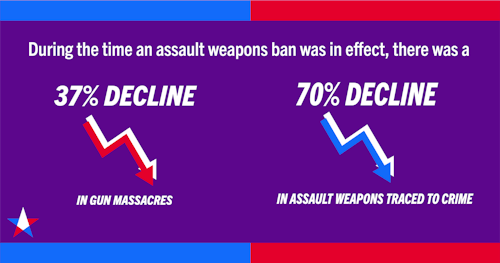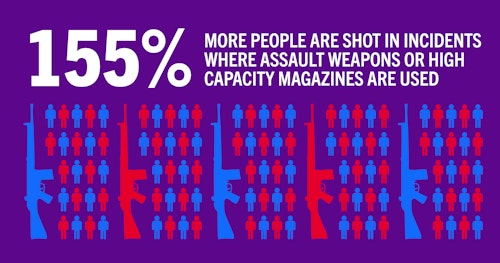What are Assault Weapons and Large-Capacity Magazines?
Assault weapons, paired with large-capacity magazines, have long been the weapon of choice for mass shooters.
These weapons of war have no place on American streets.
What are Assault Weapons?
An “assault weapon” refers to a semi-automatic gun designed for military use and quick, efficient killing. Assault weapons are uniquely lethal because of their rapid rate of fire and high muzzle velocity — coupled with large-capacity magazines, which attach to an assault weapon to allow dozens of gunshots without needing to reload. A large-capacity magazine is typically defined as any magazine or drum that is capable of holding more than either 10 or 15 rounds of ammunition.
Military-style assault weapons and large-capacity magazines exist only to enact maximum destruction, and there’s simply no reason that everyday Americans need access to them.
In shootings where assault weapons or large-capacity magazines are used, 155 percent more people are shot, and 47 percent more people are killed.

The Federal Assault Weapons Ban of 1994
In 1994, Congress enacted a federal assault weapons ban as part of the Violent Crime Control and Law Enforcement Act of 1994, commonly known as the “crime bill.” A ban on assault weapons was supported by former Presidents Gerald Ford, Jimmy Carter, and Ronald Reagan. The Violent Crime Control and Law Enforcement Act named 19 guns (and their copies) as well as other semi-automatic firearms with two or more specified features listed above. It was signed into law by President Bill Clinton.
The federal assault weapon ban expired on September 13, 2004. Congress did not renew it. When it expired, assault weapons and large-capacity magazines were suddenly legalized, unless banned by state or local laws.
We know that assault weapon bans work because data proves it. For the decade that the federal assault weapons ban was in effect from 1994 to 2004, 89 people died in 12 massacres. But in the decade after the ban expired from 2004 to 2014, over 300 people were shot and killed in 34 mass shootings. That’s a staggering 183 percent increase in massacres and a 239 percent increase in fatalities.

State Legislation Banning Assault Weapons and Large-Capacity Magazines
Currently, 10 states (Washington State, Illinois, Delaware, California, Connecticut, Hawaii, Maryland, Massachusetts, New Jersey, New York) and Washington, D.C, ban assault weapons, and two more regulate elements of their possession or purchase. These laws are all slightly different, but all work to prevent these weapons of war from being readily available to the general public.
Additionally, 11 states and the District of Columbia have banned large-capacity magazines — though like assault weapon laws, the regulations slightly differ. The National Law Enforcement Partnership considers anything above 10 rounds as high or large-capacity and advocates for their limitation from civilian access and use. While the Supreme Court case Heller v. District of Columbia has recognized the right of law-abiding citizens to own a gun in the home for self-protection, courts have widely upheld state assault weapon and large-capacity magazine bans as constitutional.
Kyleanne Hunter, Brady's former Vice President of Programs and a Marine Corps combat veteran, talks about AR-15s and weapons of war.
Why Should We Regulate Assault Weapons and Large-Capacity Magazines?
*Mass shootings involving assault weapons or large-capacity magazines are far deadlier, and the death and injury counts of each mass shooting have been rising in recent years. From 2009 to 2013, an average of 7 people were shot during each mass shooting. In the five years following, this average increased by 15%. Assault weapons, paired with large-capacity magazines, are often the weapon of choice for public mass shooters. The shooter at Marjory Stoneman Douglas High School in Parkland, Florida, killed 17 people using an assault weapon. But this was just one in a long list of horrific shootings committed with these weapons. Assault weapons were also used in:
- The Marjory Stoneman Douglas High School shooting, 17 killed and 17 injured;
- The Tree of Life Synagogue shooting, 11 killed and 6 more injured;
- The Sutherland Springs church shooting, 26 killed and 20 more injured;
- The Las Vegas music festival shooting, 59 killed and over 500 more injured;
- The Pulse Nightclub shooting, 49 killed and 53 more injured;
- The San Bernardino Community Center shooting, 14 killed and 22 more injured;
- The Sandy Hook Elementary School shooting, 26 killed and 2 more injured;
- The Aurora, Colorado, movie theatre shooting, 12 killed and 58 more injured;
- The Dayton, Ohio, shooting outside of a bar, nine killed and at least two dozen others;
- The Gilroy, California, garlic festival shooting, 3 killed and 17 injured;
- The Odessa-Midland, Texas, shooting, 7 killed and more than 20 injured;
- The El Paso, Texas, shooting at a Walmart, 22 killed and 24 injured.
- The Springfield, Missouri, convenience store shooting, five killed;
- The Boulder, Colorado, grocery store shooting, 10 killed
- The Robb Elementary School Shooting, 21 killed and 17 injured;
- The Buffalo, New York, grocery store shooting, 10 killed and 3 injured;
- The Highland Park, Illinois, parade shooting, 7 killed and 40 injured;
- The Allen, Texas, outlet mall shooting, 8 killed and 7 injured.
*An analysis of mass shootings between 2009 to 2018 shows that in shootings where assault weapons were used, six times as many people were shot compared to those without them. Similarly, when large-capacity magazines were used in a mass shooting (59% of the time), five times as many people were shot compared to massacres carried out without them. These weapons also make our law enforcement officers less safe — in 2014, one in five officers killed in the line of duty were killed by assault weapons. Over a third of law enforcement agencies surveyed after the expiration of the federal assault weapon ban reported that they experienced a noticeable increase in criminals’ use of assault weapons.
We know that regulating assault weapons can save lives: during the time the assault weapon ban was in effect, there was a 37 percent decline in gun massacres and a 70 percent decline in the percentage of assault weapons traced to gun crimes. Law enforcement organizations have long supported laws prohibiting assault weapons because the agencies charged with protecting the public are effectively being “outgunned” by militarized civilians and criminals with easy access to assault weapons and large-capacity magazines.

Pending Legislation and How to Take Action Against Assault Weapons
In January 2019, Sen. Dianne Feinstein (D-CA) and Rep. David Cicilline (D-RI 1) introduced the Assault Weapon Ban of 2019. This life-saving legislation would ban the sale, manufacture, transfer, and importation of 205 military-style assault weapons by name, as well as outlaw any assault weapon that can accept a detachable magazine and has one or more military characteristics. But under the leadership of Sen. Mitch McConnell, Congress failed to bring this life-saving legislation up for a vote. In 2021, the legislation was reintroduced, and while the assault weapons ban was passed in the House of Representatives, it failed to come to a vote in the Senate. Now, in the 118th Congress, we're again calling on the U.S. Senate to pass S. 25, the Assault Weapons Ban of 2023 — legislation re-introduced by Sen. Dianne Feinstein (D-CA) to ban assault weapons and large-capacity magazines.
The proposed Assault Weapon Ban of 2023 is similar to the 1994 assault weapon ban but notably different in that it requires only one additional feature, instead of two. It also bans any large-capacity magazine that can accept any more than 10 rounds of ammunition, along with bump stocks and other devices that allow semi-automatic weapons to fire at a rate that mimics fully automatic weapons. Any gun or large-capacity magazine that is lawfully possessed at the day of enactment will be grandfathered in and exempted from the ban.



